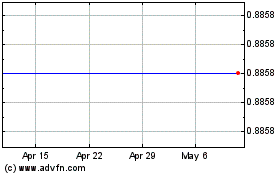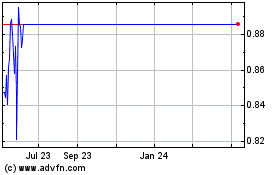Dark Pool' Settlements Bring Tangled Relationships to Light
February 01 2016 - 7:33PM
Dow Jones News
By Scott Patterson
The latest round of penalties over "dark pools" highlights how
reliant banks and exchange operators have become on business from
high-frequency traders--even on platforms that promised to blunt
their advantage.
Dark pools were advertised to mutual funds and other traditional
money managers as a place where they could trade in secret and
avoid giving away their moves to computer-driven traders. New
settlements with two of the biggest dark-pool operators, Credit
Suisse Group AG and Barclays PLC, showed that the banks were
quietly catering to high-frequency traders at the same time.
The reality beneath those practices is that high-frequency
traders account for the bulk of bids and offers that keep the
market running--about two-thirds of the total--a source of business
that can be hard to pass up. Credit Suisse and Barclays catered to
them by concealing the role of speedy traders on their platforms
and going back on promises to protect clients from predatory
trading, according to the settlements with the Securities and
Exchange Commission and New York Attorney General.
The often opaque ties between exchanges, dark pools and
high-speed firms have been one of the most perplexing issues facing
investors and regulators. In recent years, firms accused of masking
their links to superfast trading outfits have been hit with a
series of escalating fines.
In 2011, the Securities and Exchange Commission fined Pipeline
Trading Systems LLC $1 million for failing to disclose to clients
that they were often trading with an in-house high-speed firm. BATS
Global Markets Inc. last year agreed to pay $14 million to settle
allegations that two exchanges it ran failed to disclose certain
details about their markets that the SEC said gave advantages to
some high-speed traders. UBS Group AG a year ago agreed to pay
$14.4 million to settle allegations that it failed to inform all
clients about advantages its dark pool gave to some firms,
including high-frequency traders. Pipeline, BATS and UBS didn't
admit or deny the allegations.
The emergence of dark pools and high-frequency trading went hand
in hand as trading increasingly shifted from floor-based open
outcry models to one largely controlled by computers.
Trading on dark pools, which, unlike exchanges don't publish buy
and sell orders, took off about 15 years ago. Dark pools largely
were used by institutional firms hoping to trade large chunks of
stocks without alerting the broader market to their activities.
At about the same time, trading by high-frequency firms also
took off. Large traders such as mutual funds grew concerned that
high-speed traders were hurting them by detecting their orders on
exchanges and trading ahead of them. Many of the firms turned to
dark pools, hoping the opaque venues would protect them from such
activities.
The problem was that most dark pools also catered to
high-frequency firms. Some weren't entirely forthcoming to their
clients about their reliance on high-speed traders, regulators have
found. Worse, they told clients they would protect them from
predatory high-speed trading while hiding how much of their order
flow depended on the firms' frenetic activities.
Credit Suisse and Barclays this week agreed to pay a combined
$154.3 million to settle allegations that they misled investors
about high-frequency trading activities on their dark pools.
Barclays told clients that its dark pool, called LX, protected
them from predatory trading using its "Liquidity Profiling" system,
which it said could detect such activity, according to the SEC.
Trades were categorized in buckets ranked from zero to five, with
zero the most predatory, and clients could elect to not trade with
low-ranked firms.
But Barclays often shifted traders assigned a low ranking into a
higher ranking, the SEC said. Because of that, certain clients
traded with firms ranked "in the most aggressive categories," the
SEC said. Barclays also presented marketing material describing the
types of clients on LX that omitted its largest subscriber--a
high-frequency trader.
Credit Suisse, meanwhile, told clients its dark pool would give
predatory traders a negative score, a program "intended to address
certain subscriber concerns about interacting with high-frequency
trading firms," the SEC said.
Clients could choose not to trade with firms with a bad score.
But the systems didn't perform as Credit Suisse said it should
since it included "significant subjective elements," the SEC
said.
The Swiss bank also didn't disclose that it ran a trading system
that alerted two high-frequency firms about the existence of orders
placed by other clients, the SEC said.
(END) Dow Jones Newswires
February 01, 2016 19:18 ET (00:18 GMT)
Copyright (c) 2016 Dow Jones & Company, Inc.
Credit Suisse (NYSE:CS)
Historical Stock Chart
From Mar 2024 to Apr 2024

Credit Suisse (NYSE:CS)
Historical Stock Chart
From Apr 2023 to Apr 2024
